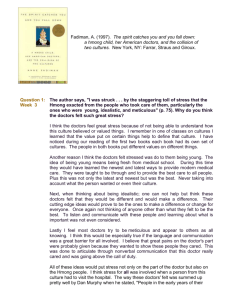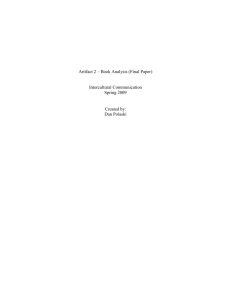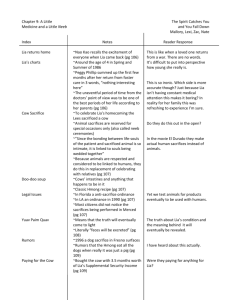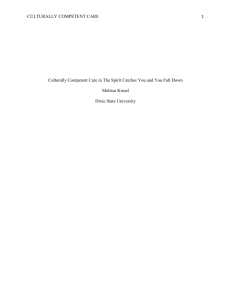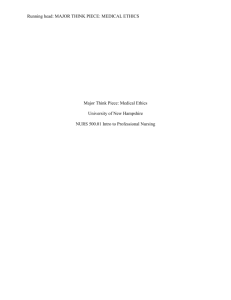101Lecture_14-The_Spirit_Catches_You_5-7
advertisement
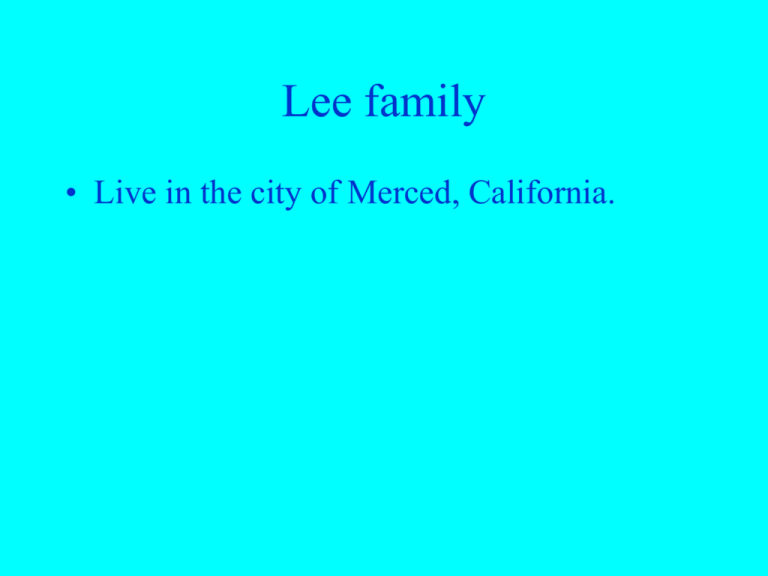
Lee family • Live in the city of Merced, California. Lia Lee • Born on July 19, 1982. Lia Lee • When Lia was three months old, her older sister Yer slammed the door of the Lee’s apartment. • Moments later, Lia’s eyes rolled up, her arms jerked over her head, and she fainted. • Despite the hu plig ceremony, the noise was so scary that Lia’s soul fled her body and became lost. • A dab stole Lia’s soul. Qaug Dab Peg = Epilepsy Epilepsy • A neurological disorder (a physical condition) which causes sudden bursts of electrical energy in the brain. • These discharges produce sudden, brief seizures. Epilepsy • Hmong feel ambivalent toward this condition. • It is seen as both dangerous and as a sign of distinction. • Hmong epileptics often become txiv neeb Txiv Neeb = Shaman • Literally: A person with a healing spirit Txiv neebs • Act toward their patients in ways that are culturally acceptable, and in general, more pleasant than the ways of Western doctors. Txiv neebs • Know how to treat illnesses with herbs. • The only medicines Hmong gladly accepted from Western doctors were antibiotics. Foua and Nao Kao Lee • Highly attentive and caring toward Lia. Two-Pronged Approach • Services of Western doctors at Merced Community Medical Center (MCMC) and • Services of Hmong shamans. Jeanine Hilt • A social worker. • Only person, out of 40, who asked Lia’s parents what they thought was the cause of her illness. • Despite the fact that 20% of Merced’s population is Hmong, the State has not funded interpreters to help communication between doctors and patients. • On the first time that Foua and Nao Kao carried Lia to MCMC’s emergency room, there was nobody available for translation. • Since seizures had stopped, they could not explain to doctors what had happened. • Residents identified bronchial congestion, which was caused by aspiration of saliva during the seizure, and prescribed an antibiotic. • Nao Kao was told to sign a paper, where he supposedly acknowledged receipt of instructions for administering the medicine, and agreed to call for a follow-up appointment. • He had no idea what he had agreed to. • The third time, the Lees were accompanied by a cousin who spoke some English. • The Lees were instructed to give Lia 250 milligrams of ampicillin twice a day, and twenty milligrams of Dilanti, an anticonvulsant, twice a day, to suppress further seizures. Lia’s condition was severe • Between the ages of eight months and four and a half years, she was admitted to MCMC seventeen times and made more than a hundred outpatient visits. Grand Mal Episodes • Full-blown seizure attacks characterized by long periods of loss of consciousness. • When the brain is deprived of oxygen, as is the case with prolonged seizures, significant brain damage occurs. • Lia’s disorder was much more severe than a case of classic epilepsy. Paediatricians: Neil Ernst and Peggy Philip • Lia was overweight. • This made it very difficult to find her veins and insert the intravenous needles necessary to administer her medicine. • Doctors had a hard time getting Lia to take her medications. • The Lees had an even harder time, because they didn’t like to restrain her or force anything down her throat. • Over time, Lia’s drug regimen became so complicated and was revised so many times, that it would have been very confusing even for a family that could read English. • For the Lees, it was just incomprehensible. • Prescriptions changed twenty-three times in less than four years. • Foua and Nao Kao could not read medicine labels, neither in English nor in Hmong. • They couldn’t read markings on droppers or measuring spoons. • They weren’t able to read temperature in a thermometer. • Lia’s parents never really understood the connection between a seizure and what it did to the brain. • Drugs had different and significant sideeffects, such as diarrhea and hyperactivity. • For Nao Kao and Foua, the treatment was a crisis, not the epilepsy. They understood that not everything is in our control. • Doctors began to see signs of developmental delay in Lia. • Neil and Peggy found this situation tragic, because they thought it was preventable. • Neil wrote to the Health Department and to Child Protective Services. • What the doctors viewed as the basic tools of modern medicine (blood tests, spinal taps, surgery, anesthesia, and autopsies), the Hmong saw as practices that threatened the seat of their identity, in fact, of their souls. Questions: 1) Dr. Dan Murphy said, “The language barrier was the most obvious problem, but not the most important. The biggest problem was the cultural barrier. There is a tremendous difference between dealing with the Hmong and dealing with anyone else. An infinite difference” (p.91). What does he mean by this? 2) Dr. Neil Ernst said, “I felt it was important for these Hmongs to understand that there were certain elements of medicine that we understood better than they did and there were certain rules they had to follow with their kids’ lives. I wanted the word to get out in the community that if they deviated from that, it was no acceptable behavior” (p. 79). Do you think the Hmong understood this message? Why or why not? What do you think of Neil and Peggy? 3) How did you feel about the Lees’ refusal to give Lia her medicine? Can you understand their motivation? Do you sympathize with it?
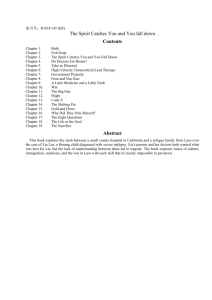
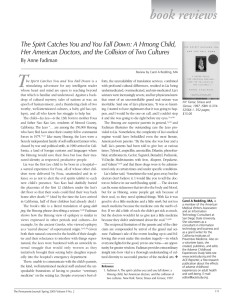
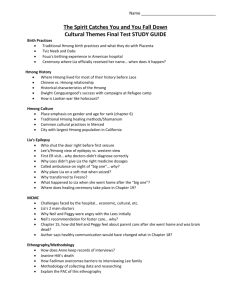

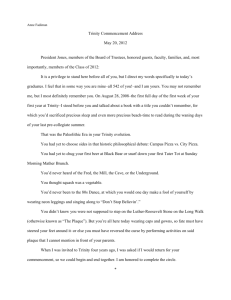
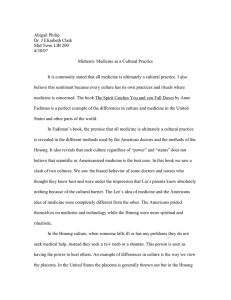
![[Type text][Type text] Sarah Grannis Com 207 Spring 2011 Book](http://s3.studylib.net/store/data/009169404_1-d4e7778b290f399e86747b373dbe2208-300x300.png)
